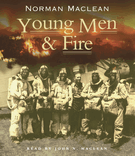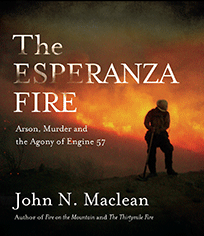 It’s interesting sometimes to reflect on how you end up settling on a particular book: The hazy day in Minnesota that the weather people attributed to western wildfires, including a huge one in Yosemite. The recent return of a colleague from a vacation in Montana—and that reminding me of my own visit there, many years ago, and the boat tour on the Missouri River, during which I first heard about the Mann Gulch Fire. That recollection of course reminding me of Norman Maclean’s Young Men and Fire, which was about that forest service disaster.
It’s interesting sometimes to reflect on how you end up settling on a particular book: The hazy day in Minnesota that the weather people attributed to western wildfires, including a huge one in Yosemite. The recent return of a colleague from a vacation in Montana—and that reminding me of my own visit there, many years ago, and the boat tour on the Missouri River, during which I first heard about the Mann Gulch Fire. That recollection of course reminding me of Norman Maclean’s Young Men and Fire, which was about that forest service disaster.
 So, although it took more than a few minutes to realize what lead me to my sudden burning—excuse the very bad pun—desire to listen to Norman’s son John N. Maclean’s new book The Esperanza Fire: Arson, Murder and the Agony of Engine 57 (read by Pete Larkin), in retrospect it seems almost inevitable.
So, although it took more than a few minutes to realize what lead me to my sudden burning—excuse the very bad pun—desire to listen to Norman’s son John N. Maclean’s new book The Esperanza Fire: Arson, Murder and the Agony of Engine 57 (read by Pete Larkin), in retrospect it seems almost inevitable.
Maclean delivers, much as you would expect a writer dubbed “the Bob Woodward of forest fires”
(National Geographic Adventures) on the research, details, and stats: The 12,000 fires a year in the US attributable to arson. The significance of a sloping hillside. The words any California firefighter dreads: “We’re expecting a Santa Ana Wind.” The meaning of the haunting terms “area ignition” and “engine burn over.” The fact that arsonists are almost always serial arsonists.
But he also delivers on the emotion and backstory: The sense that arsonists are as monstrous as any Son of Sam-style mass murderer; and if the arsonist hasn’t actually killed anyone yet, they are simply an unsuccessful mass murderer. The human shortcomings and mistakes of even the most veteran of firefighters. The family nature of the firefighting community and the impact when not just one or two but several fall, and fall within just a few yards of their fellow firefighters—close by and yet not close enough to save.
Maclean also delivers on a story of true crime. While the outcome of the trial—as of the fire—are a matter of public record, he strings together a narrative that, without sensationalism, captures the investigators’ efforts—part determination, part gut instinct, and part luck—that lead to the eventual identification and prosecution of the arsonist. Finally, he takes you inside the court for the first conviction of an arsonist in a capital murder case.
I always appreciate Pete Larkin’s narrations, and I definitely appreciate what he contributes to The Esperanza Fire. For his work on the Black Mask series, he was exactly the hard heavy you’d expect in a noir story. But for nonfiction, and one with a serious outcome, having an even and controlled narrator is indispensable. This isn’t a story that needs a sensationalist narration to convey its depths, and Larkin never fails to supply emotion where it belongs—and nowhere else. It can’t be easy for a narrator to achieve, however. Larkin must constantly move back and forth between the control of his narrator role and the multitudinous, emotional voices of the firefighters, their family members, and the investigators. He pulls it off smoothly.
The Esperanza Fire is ultimately a story about fighting against odds to do what is right—and how easy it can be to do incredible wrong. Although spoken in another context, a few words spoken by one firefighter form a cautionary warning for every camper, smoker, or garbage burner in California—local or visiting. It’s a warning as well for every would-be arsonist: “You don’t let a fire burn in southern Cal.”

No Comments so far ↓
There are no comments yet...Kick things off by filling out the form below.